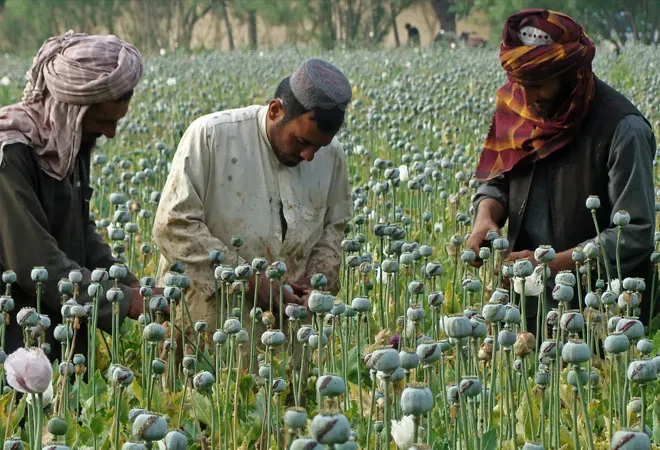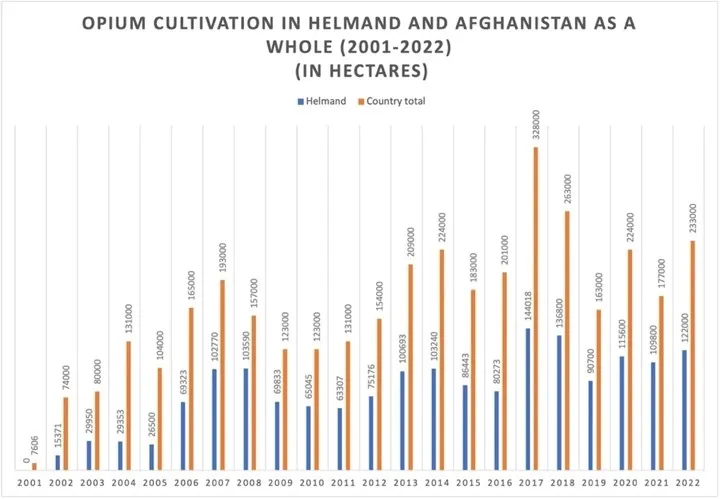
Recent reports and satellite imagery show an almost 80 percent fall in the opium crop in the south and south-western provinces of Afghanistan. The United Nations Office on Drugs and Crime (UNODC) in their latest World Drug Report also acknowledged this fall, while warning against the attendant risks that this poses for drug smuggling and the increased use of synthetic drugs. Understanding the implications of these developments necessitates an analysis of how the opium ban will affect Afghanistan, both in terms of its impact on the economy and people’s livelihood and the Taliban’s control of the country.
Recent reports and satellite imagery show an almost 80 percent fall in the opium crop in the south and south-western provinces of Afghanistan.
Gradual and careful implementation: The enforcement of the ban
Back in April 2022 when Mullah Habibullah Akhundzada first announced a
ban on the production and sale of poppy, there were concerns about the group’s seriousness in going through with it. These concerns emerged from the timing of the ban and the fact that the production of opium had increased by 8 percent in 2021 since the previous year. The UNODC subsequently reported a 32-percent increase in opium production in 2022. Other reports also showed the group
turning a blind eye to production in certain areas, with many big farmers benefiting from the increased prices owing to a
‘perception of uncertainty’ since the group’s return to power. These developments, in addition to the two-month grace period under which the crop wouldn’t be destroyed further increased speculations about the group using the ban to further legitimise their rule in the eyes of the international community and manipulate the market to gain financially.
Mansfield in his research asserts that the Taliban had planned to adopt a relatively staggered and gradual approach to tackle the drug problem in the country. On the face of it, while the public announcement of the ban and the previous statements underscoring their
commitment to making Afghanistan narcotics-free did create a narrative about the group forcefully exercising its powers and cracking down on violators, the reality of governance compelled them to take a much more slow and gradual process on the ground.
The optics were intended to discourage the farmers from planting opium in the next planting season while reducing the more difficult task of forcefully eradicating the crop and inviting public anger and discontent.
The group first focused on ramping up pressure on the drug producers and targeting the spring and summer crops in the southwestern provinces of Helmand and Kandahar, while leaving the fall crop which was almost ready to be harvested. The visuals of
crops being destroyed, with around 4,000 hectares (ha) destroyed till May and 6,000 counter-narcotics operations, were to send a message. Additionally, even after the two-month grace period had lapsed, there were
no efforts to curb cultivation or trade, both within and outside Afghanistan. The opium grown before the ban continued to be sold with the sales and customs tax removed in March 2023 for a period of 10 months. The optics were intended to discourage the farmers from planting opium in the next planting season while reducing the more difficult task of forcefully eradicating the crop and inviting public anger and discontent. This approach was
fairly successful, as even though the prices
doubled in the south and increased by one-third in the east since June 2022 (Image 1), fewer crops were grown. In Helmand province, where traditionally more than half of the country’s opium cultivation used to take place, cultivation fell from 1,20,000 ha to less than 1,000 ha in 2023. (Image 2) While the relatively rich farmers will stock up on their crops for some time and sell when it will be more profitable to do so, it will be the poor farmers who work on others’ lands as sharecroppers who will bear the brunt, in turn reinforcing the existing inequalities.
 Source: Alcis
Source: Alcis
The ban on ephedra proclaimed in
December 2021 escaped scrutiny but this decision was important both from the perspective of bringing down the percentage of poppy crop grown and raising the risk of the proliferation of more synthetic drugs. The plant is a key ingredient in methamphetamine and more and more
farmers are turning to the industry. While a relatively small number of farmers were involved in its production, the ban benefited everyone along the supply chain, with the prices rising to 570 US$/kg in 2022 from 0.63 US$/kg and the
Taliban still taxing the traders.
The indispensability of opium cultivation in Afghanistan
The cultivation of opium poppy is an important aspect of the Afghan economy. With the country oscillating between war and civil unrest for a major part of its history, efforts to establish sustainable forms of employment have all but failed. Thus, trade in opioids has become indispensable for people ravaged by disaster and destruction owing to its suitability to the geography of the region, its drought resistance and the higher prices that it attracts. In 2021 its share in the economy was between
9-14 percent of the GDP. Back in 2000-2001, the Taliban banned opium. The conditions of the country as well as the
tactics employed were
similar but the ban was announced a few months prior to the planting season and after the group had been in power for some time. While the production fell by more than
90 percent, the fall of the Taliban in 2001 and the subsequent emergence of the US-backed government undid the progress, with cultivation picking up in the following years.
Domestically as well, the number of addicts in the country has seen a steep rise, approximately 10 percent of the population, with the political transition in 2021 and the consequent hardships pushing more people towards addiction and substance abuse.
In 2020, 85 percent of the world’s opium came from Afghanistan. It is smuggled to countries as far across as Europe and Southeast Asia, with a myriad number of routes and networks crisscrossing across the world. Domestically as well, the number of addicts in the country has seen a steep rise, approximately
10 percent of the population, with the political transition in 2021 and the consequent hardships pushing more people towards addiction and substance abuse. The Taliban has been rounding up addicts from the cities and sending them to the rehabilitation centres in the country which are also in dismal conditions.
 Source: Afghanistan Analysts Network
Source: Afghanistan Analysts Network
An average Afghan family is very deeply entwined within the opium supply chain which is why the eradication drives have also invited opposition, with many
local commanders going on these drives in groups and receiving retribution from their village neighbours and elders. To assuage the concerns of the people,
the IEA has been trying to place cotton as a viable alternative to poppy with reports citing an increase in cultivation from
10 percent to 40 percent in the of a year. Wheat is also being projected as an alternative. The fall in the cultivation of poppy led to an increase in the cultivation of wheat in the same areas but with slender profit margins, the possibility of poorer farmers adopting it seems bleak.
Motivations and implications: (Un)expected consequences of the ban.
Speculations about the motivations behind the ban have hovered from solely religious reasons and the influence of Akhundzada to an effort to gain international legitimacy by using the ban as a bargaining chip. As opium is a relatively
less problematic policy area to rule on as compared to women’s rights, it is also viewed as a means of shifting the debate from other contested issues. But none of these arguments explains the steady alacrity with which the group has acted. The IEA’s spokesperson, in his response to the World Drug Report 2023 released by the UNODC, applauded the seriousness that the Taliban showed in cracking down on opium cultivation, and bringing down production to ‘zero’. Welcoming parts of the report, he refuted the assertions about an increase in methamphetamine production in the country and urged the international community to assist them in providing alternate means of livelihood and support for the treatment and rehabilitation of addicts. The growing fear of substance abuse inside the country and the disastrous impact it could have may have influenced this decision, something that the
Taliban has also highlighted.
The possibility of people from the affected provinces migrating to neighbouring countries and eventually to Europe is also present. In regions, particularly the east where the landholdings are small, the resistance could also grow eventually.
For India, placed between the major drug smuggling routes, the smuggling of drugs from Afghanistan’s
southern route and a
rise in seizures in the past few years indicate that the drop in opium production will have some positive consequences. After the bust of approx. 3 tonnes of Afghan heroin worth
US$ 200 billion at the port of Mundra, Gujarat in September 2021, the National Crimes Bureau has been particularly suspicious of an increase in drug seizures, especially through the
maritime route. But while the fall in opium production this year will eventually reflect in the quantity smuggled in a few years
, the seizure of methamphetamine worth 3,200 kg since February 2022 hints at a disastrous change in the drug smuggling nexus—with a shift towards more synthetic drugs and methamphetamine emerging as the
‘fulcrum of the new terror-narco’ matrix. The seizure of synthetic drugs has also increased in some
Central Asian Republics. As per
Afghanistan Analysts Network (AAN), while international responses have been few, some commentators in Pakistan have welcomed the decision, hopeful of the ban cutting a major source of revenue for the TTP militants. The US has also
acknowledged the drop, though scepticism about the ban’s long-term impact persists.
Afghanistan’s aid budget has been reduced to US$ 3.2 billion owing to a changed
operational context. In an already precarious economic situation, the inability to profit from opium’s cultivation and trade can push even the relatively well-off farmers towards poverty,
alienating them further. The possibility of people from the affected provinces migrating to neighbouring countries and eventually to Europe is also present. In regions, particularly the east where the landholdings are small, the resistance could also grow eventually. While countries are still navigating how best to deal with the Taliban, the far-reaching implications of these policy changes and their unprecedented impact on the region warrant attention. The bigger question for the Taliban is whether they’ll be able to continue the enforcement in the second year and how it handles the growing resistance.
Shivam Shekhawat is a Research Assistant with the Strategic Studies Programme at Observer Research Foundation
The views expressed above belong to the author(s). ORF research and analyses now available on Telegram! Click here to access our curated content — blogs, longforms and interviews.



 Recent reports and satellite imagery show an almost 80 percent fall in the opium crop in the south and south-western provinces of Afghanistan. The United Nations Office on Drugs and Crime (UNODC) in their latest World Drug Report also acknowledged this fall, while warning against the attendant risks that this poses for drug smuggling and the increased use of synthetic drugs. Understanding the implications of these developments necessitates an analysis of how the opium ban will affect Afghanistan, both in terms of its impact on the economy and people’s livelihood and the Taliban’s control of the country.
Recent reports and satellite imagery show an almost 80 percent fall in the opium crop in the south and south-western provinces of Afghanistan. The United Nations Office on Drugs and Crime (UNODC) in their latest World Drug Report also acknowledged this fall, while warning against the attendant risks that this poses for drug smuggling and the increased use of synthetic drugs. Understanding the implications of these developments necessitates an analysis of how the opium ban will affect Afghanistan, both in terms of its impact on the economy and people’s livelihood and the Taliban’s control of the country.


 PREV
PREV


